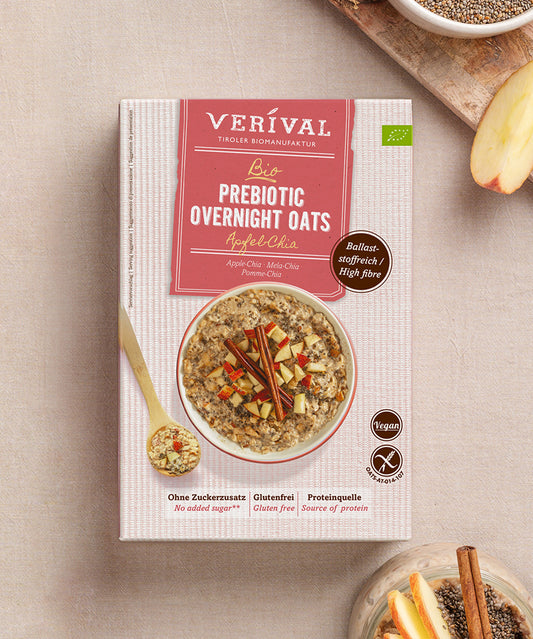In traditional Chinese medicine, or TCM for short, it is yin and yang; in Ayurveda, it is the three doshas. Sometimes one predominates, sometimes the other. Although the philosophy of the two health systems may at first glance sound very different, they have some similarities.
Both teachings advocate the view that body and mind form a unity. One cannot exist without the other. In nutritional science, too, the two concepts overlap in many ways.
For example, both TCM and Ayurveda state that warm food is better for us than cold food. This applies above all to the first half of the day, and thus particularly to breakfast.
Now you will learn what the differences are between the two teachings of TCM and Ayurveda, and where they agree.
What is behind TCM and Ayurveda
While Traditional Chinese Medicine (TCM), as the name suggests, comes from China, Ayurveda originated in India. Both concepts are several thousand years old.
What connects them is their holistic approach to physical and mental health. Body and mind are seen as one.
TCM – the doctrine of Qi
The TCM doctrine is based on the idea that the body is permeated by a life force, Qi, which flows through the body along channels known as meridians. This is a network of energy channels that extends throughout our entire body. As soon as the energy can no longer flow freely, blockages become noticeable through illnesses.
These blockages are removed using various TCM methods so that the energy can flow freely again. These methods include acupuncture, physical and breathing exercises (Qigong), massages and nutrition according to TCM.
Ayurveda – balancing the doshas
Ayurveda is based on the concept of three vital energies (doshas) – vata, pitta and kapha – which are composed of the five elements of earth, water, fire, air and space. These energies are responsible for bodily functions. In most cases, one or two doshas are dominant, thereby determining our constitutional type.
If there is an imbalance of the vital energies, everyday ailments and illnesses arise. To bring the doshas into balance, methods such as massages, cleansing techniques, yoga, herbal medicine and nutrition according to Ayurveda are used.
Nutrition according to TCM and Ayurveda – how it works!
As different as the two systems may appear at first glance, when it comes to nutrition, they are largely in agreement. The nutritional teachings of both concepts are not about calories and nutrition tables, but about finding the right foods for the respective nutritional type.
In TCM, nutrition works according to the 5-element theory. In Ayurveda, on the other hand, it follows the characteristics of the doshas. Both theories recommend a different diet depending on your constitution.
This type of personalized nutrition can be a bit overwhelming at first. It takes a little patience and practice to learn to correctly interpret the signals from your own body and environmental influences.
Fortunately, in addition to type-specific nutrition, there are also basic principles that apply to everyone. This makes it much easier to get started with TCM or Ayurvedic nutrition.
The following three basic principles can be found in both Far Eastern nutrition concepts:
- Eat regionally and seasonally
- Warm meals are better than cold ones
- Combine all flavors
Eat regionally and seasonally
You don't have to live in India or China to follow Ayurvedic or TCM principles. It is important to eat seasonal and regional foods.
Both philosophies state that foods that grow in our immediate vicinity have a healing effect on us. It is not without reason that we tend to enjoy stews with potatoes and root vegetables in winter and crunchy salads with fresh cucumbers and tomatoes in summer.
Better warm meals than cold ones
What both teachings absolutely agree on: warm meals are simply better for us. This is because the food is already at body temperature and therefore easier to digest. Warm meals support the Ayurvedic digestive fire Agni just as much as Qi in TCM.
In TCM, a warm breakfast plays a particularly important role. According to traditional Chinese medicine, each organ is at its peak at a certain time. For example, the stomach is at its peak between 7 and 9 a.m. That's where the saying “breakfast like an emperor, lunch like a prince, and dine like a pauper” comes from.
To help you start the day in the best possible way, we have developed three porridges based on TCM philosophy, which can also be wonderfully combined with Ayurvedic nutrition. For example, the classic Ayurvedic spices turmeric and cardamom give our coconut-orange rice porridge its delicious flavor.
Combine all flavors
The combination of flavors is also a common feature of the two traditional medical systems Ayurveda and TCM.
According to both teachings, all flavors should be included in every meal. In TCM, these are sweet, sour, bitter, spicy and salty. In Ayurveda, on the other hand, astringent, which is often also referred to as astringent, is added. If all these flavors are found in a meal, it is said that the well-known cravings for sweets after a meal do not occur.
To combine all flavors in one meal, spices play an important role, especially in Ayurveda.
Let's take our sour cherry cocoa oat porridge from the TCM series as an example. A glance at the ingredients shows that this breakfast combines all flavors:
- Sweet: Cereals in general are considered sweet in TCM and Ayurveda. This flavor is already covered by the superfood oats.
- Sour: The sour cherries provide the sour flavor.
- Bitter: Cocoa provides the bitter note.
- Spicy: We use cinnamon as the spicy ingredient.
- Salty: A pinch of salt ensures that the salty flavor is also represented and also brings out the sweetness better.
- Tart: By adding fresh fruit such as pomegranate seeds, apples or pears, you can also give your breakfast the added flavor of Ayurveda. Another option: Enjoy a cup of green or black tea with your porridge.
























